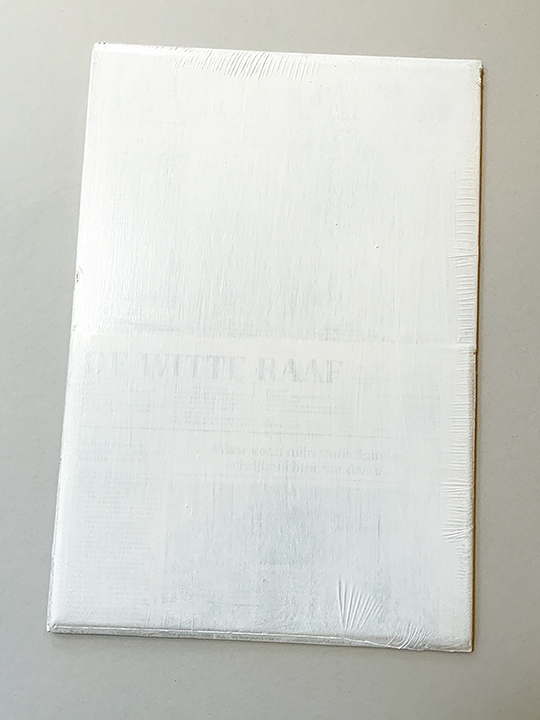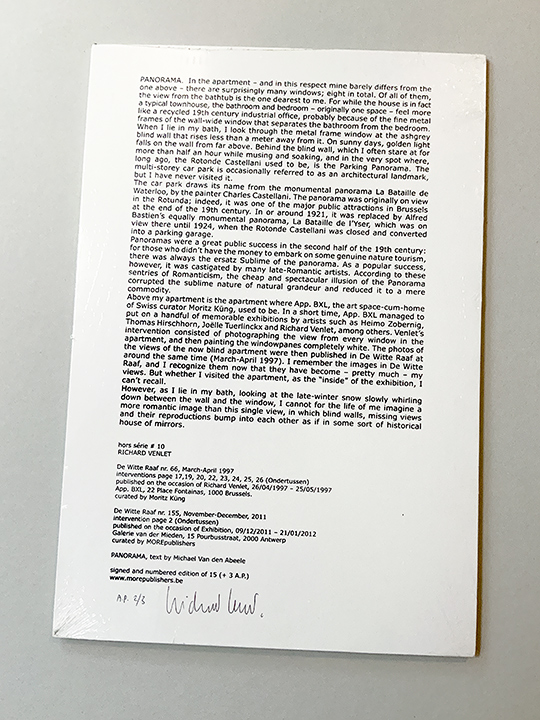Michael Van Den Abeele / Richard Venlet - Untitled
Signed and numbered edition of 15 (+ 3 A.P.
PANORAMA. In the apartment – and in this respect mine barely differs from the one above – there are surprisingly many windows; eight in total. Of all of them, the view from the bathtub is the one dearest to me. For while the house is in fact a typical townhouse, the bathroom and bedroom – originally one space – feel more like a recycled 19th century industrial office, probably because of the fine metal frames of the wall-wide window that separates the bathroom from the bedroom. When I lie in my bath, I look through the metal frame window at the ash-grey blind wall that rises less than a meter away from it. On sunny days, golden light falls on the wall from far above. Behind the blind wall, which I often stare at for more than half an hour while musing and soaking, and in the very spot where, long ago, the Rotonde Castellani used to be, is the Parking Panorama. The multi-storey car park is occasionally referred to as an architectural landmark, but I have never visited it.
The car park draws its name from the monumental panorama La Bataille de Waterloo, by the painter Charles Castellani. The panorama was originally on view in the Rotunda; indeed, it was one of the major public attractions in Brussels at the end of the 19th century. In or around 1921, it was replaced by Alfred Bastien’s equally monumental panorama, La Bataille de l'Yser, which was on view there until 1924, when the Rotonde Castellani was closed and converted into a parking garage.
Panoramas were a great public success in the second half of the 19th century: for those who didn’t have the money to embark on some genuine nature tourism, there was always the ersatz Sublime of the panorama. As a popular success, however, it was castigated by many late-Romantic artists. According to these sentries of Romanticism, the cheap and spectacular illusion of the Panorama corrupted the sublime nature of natural grandeur and reduced it to a mere commodity.
Above my apartment is the apartment where App. BXL, the art space-cum-home of Swiss curator Moritz Kung, used to be. In a short time, App. BXL managed to put on a handful of memorable exhibitions by artists such as Heimo Zobernig, Thomas Hirschhorn, Joëlle Tuerlinckx and Richard Venlet, among others. Venlet's intervention consisted of photographing the view from every window in the apartment, and then painting the windowpanes completely white. The photos of the views of the now blind apartment were then published in De Witte Raaf at around the same time (March-April 1997). I remember the images in De Witte Raaf, and I recognize them now that they have become – pretty much – my views. But whether I visited the apartment, as the “inside” of the exhibition, I can’t recall.
However, as I lie in my bath, looking at the late-winter snow slowly whirling down between the wall and the window, I cannot for the life of me imagine a more romantic image than this single view, in which blind walls, missing views and their reproductions bump into each other as if in some sort of historical house of mirrors.
Text by Michael Van den Abeele

